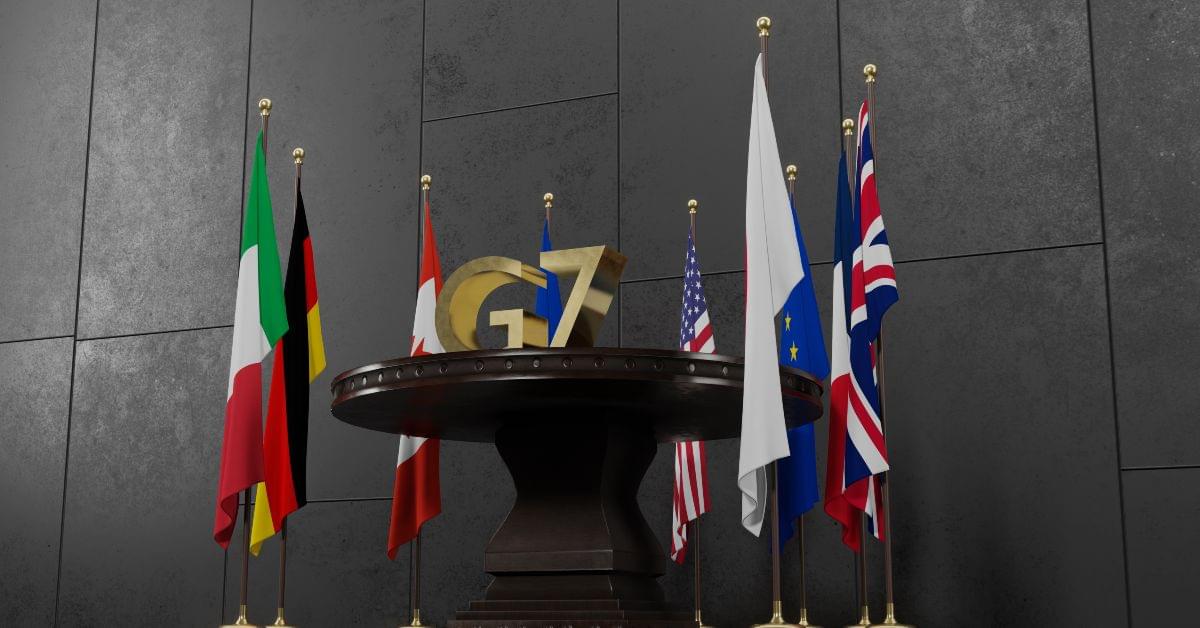
The 49th G7 Summit 2023 came to an end last week in Hiroshima, following four days of headline-grabbing activity from some of the world’s most influential political players. While Volodymyr Zelenskyy’s appearance stole much of the media attention, we saw a flurry of announcements covering topics from supply chain resilience to economic coercion and green subsidies.

Do high-level events like the G7 Summit 2023 really impact the currency markets?
These sorts of events are particularly interesting for those of us following the FX markets for their long-term impact. In most cases, we don’t necessarily see an immediate impact like we do on speeches from key central bank players. Instead, we’re looking at signs of changes in the wider financial or economic system and how these could affect the currency markets further down the line.
Here are some of the key takeaways from this year’s G7 talks.
Commitment to building strong supply chains
One of the top items on the agenda was to strengthen supply chains globally following the impact of both the covid-19 pandemic and the war in Ukraine. Both of these, as we’re all aware, have caused significant disruption, which in turn has pushed prices higher for businesses and ordinary consumers around the globe.
The G7 countries, then, have agreed to a deadline at the end of this year to finalise a plan to make supply chains more resilient. The key thrust in what we’ve seen of policy proposals so far is on diversification, particularly through providing aid to low- and middle-income countries. This would both help to integrate new supply chains and support their growth in key areas such as processing manufacturing parts and refining materials. In the event of further global disruption, this strategy of diversification should help to reduce some of the impact.
Likewise, seeing protection for key elements like semiconductors and other manufacturing parts being near-shored or even on-shored, larger economies, particularly the United States, hope to make themselves more resilient against disruption from unexpected corners. Europe has been considered a “safe bet” for decades, but the invasion of Ukraine has shown this to be overly optimistic; it’s a reminder that nowhere is truly futureproof.
Pushback against Chinese economic influence
The discourse around the People’s Republic of China has become far more bullish than ten years ago, and the G7 summit 2023 explicitly condemned the country’s “economic coercion” and resolved to put in place measures to protect against it. With UK Prime Minister Rishi Sunak calling China “the greatest challenge of our age”, America’s Joe Biden took a somewhat more mollified tone but nonetheless made clear the intention to “de-risk and diversify [the] relationship with China.”
Among the most significant announcements is the establishment of the G7 Coordination Platform on Economic Coercion. While it’s not yet entirely clear how this will look in detail, we do know that it will involve rapid information sharing between partners on events of economic coercion, as well as “reducing vulnerabilities and countering malign practices that exploit and reinforce them” – an indicator that this will be an active policy of pushback.
Many observers noted the presence of an unusual number of guests from outside the G7 itself. Asia-Pacific and Lat-Am representatives came from, among others, Vietnam, South Korea, Australia, Brazil, India, Indonesia and Comoros. All these have the potential to be critical partners in a fightback against Chinese economic influence and many currently tread a diplomatic line between the West and China.
For many years, Chinese investment in developing regions has been seen as an important driver of its influence, with relatively little counteraction from other powers. With growing attempts to circle the (economic) wagons among like-minded and not-so-like-minded nations, this could be another sign of a sea change towards a nation that is still undeniably a key part of the global economy.
Could we therefore see less confidence behind China’s attempts to grow its influence in key areas of the global economy, including the petroyuan? Time will tell, but we may find that, if successful, we see a greater shoring-up of Western economies – and currencies – in what has sometimes been expected to be “the Chinese century”.
Mixed messages on green incentives
Industrial subsidies, particularly in new green tech, have played a big part in discussions between the EU, UK and US in recent years, particularly since the introduction of the Inflation Reduction Act (IRA) in 2022 in America.
While the expected impact of the IRA in reducing greenhouse gas emissions to 40% below 2005 levels has met with widespread approval, the methods it employs to do so have been an economic worry for many European economies. It provides for significant tax credits, incentives and investment into clean energy, to a total of $157 billion – but only where production and final assembly are US-based.
The EU has been attempting for some time to work out a deal with the United States to share in these billions of dollars in investment, and Ursula von der Leyen used the G7 summit 2023 to ask for fair play, saying that together everyone should “go faster and further”, with “competition [creating] additional manufacturing capacity and not at each other’s expense.”
However, the results aren’t quite clear-cut. The US is not changing course on its own policy of subsidisation, particularly with elections next year, although it stated that it will “work to ensure regulations and investments will make clean energy affordable for all nations.” In other words, the US will continue its made-in-USA (or “finished-in-USA”) policy but with the carrot that continued growth should make accessing the results of this cheaper worldwide.
However, although there doesn’t seem to be a commitment to moving more elements outside of US borders, the same statement does highlight that they will “specifically…coordinate efforts among G7 countries to promote production and trade…[and]…a circular economy for clean energy and goods.”
If we do see further movement on this last element, we will likely see a significant boost to the green sector in the EU and UK’s economies – particularly as the UK to date is avoiding significant subsidies. If we do not, on the other hand, then we’ll see another area in which the US will outpace its Western allies.

What do these policy signals mean for the currency markets?
As we said at the beginning, this is about long-term effects. The key themes that have emerged are the need to future-proof against global disruption, the pushback against China and the debate over “fair play” in American economic growth.
If the G7 does manage to significantly grow its supply chain resilience, then the best result is that change is imperceptible – in times of global crisis, we won’t see such enormous economic shocks and consequent hits to particular currencies.
On the other hand, any heightening of economic disputes with China will likely impact both the dollar and yuan, as we saw during the “trade wars” under Trump’s administration. With China attempting to solidify its position in developing markets, some have questioned the continued dominance of the Western economic order – but perhaps we will see in decades to come that we spoke too soon.
Meanwhile, the United States’ immense economic investments are likely to continue to reinforce the strength of the dollar. However, if it comes at the expense of growth in the EU and the UK, then we may see the pound and the euro, once considered “marginal” safe havens, lose attraction for investors.
Just over three years ago, very few observers would have expected G7 to be discussing the impact of a global pandemic, an invasion of Ukraine or in some cases even taking such a bullish position on China. None of us can truly predict what’s around the corner, let alone what paths long-term policy will take us down – so make sure that your money is always protected against risk. Find out how to do so with our explainer on forward contracts, and keep yourself up-to-date with our market commentary.
Alexander Fordham
Alexander is a writer specialising in foreign exchange and finance for companies with cross-border exposure. He’s written on topics including currency risk, international taxation and global employment for seven years. You can find him out hiking, travelling and working from Spain in the sunnier months.



